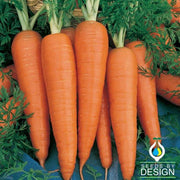Growing Non-GMO Danvers 126 Carrot Vegetable Seeds
How to Grow Danvers 126 Carrot from Seed
Open-pollinated heirloom Danvers 126 carrot seeds are a cool weather crop best sown directly in the garden in early spring or late fall. Like many root vegetables, non-GMO Danvers 126 carrot does not transplant well and should be directly sown. Plant 2-3 Danvers 126 seeds ¼" deep and 1-2" apart in very loose, well-tilled, and well-drained garden soil in full sun. Open-pollinated carrot seeds germinate in 14-21 days, thinning back to 1 plant every 2" as true leaves establish. Avoid using nitrogen-rich vegetable garden fertilizers which are known to cause carrot growth abnormalities.
Danvers 126 Carrot in the Vegetable Garden
Improved strain of danvers carrot that was introduced in 1947 by Eastern States Farmers Exchange. Danvers 126 was created for better yields, smoother skin, and uniformity. Davers 126 is a heat tolerant carrot variety that will also work in a wide range of soils. 6-7" long and about 2" at the shoulder this is a premier storage carrot. Danvers 126 resist cracking and splitting. Strong tops make it easy to pull this carrot from the garden.
Carrot is a sugary sweet root vegetable second only to the beet in overall sugar content. Carrot is one of the easiest, quickest, and most satisfying garden crops and lends itself to as many savory dishes as it does sweet. Although considered a predominantly orange vegetable, the carrot is available in a wide selection of exquisite heirloom colors such as red, purple, yellow, and white. Carrots can be sown every couple weeks for successive season-long harvesting.
Harvesting Danvers 126 Carrots
Most varieties of carrot are ready for harvest about 70-80 days from sowing, while smaller varieties such as Parisian are ready a few weeks sooner. Regardless of color, carrots are usually ripe for harvest when the root begins to show above soil.
A sandy and well-tilled garden will help in harvesting, providing a loose soil to safely uproot the carrot crop without the need for tools. For more hardened soils, use a specialized hand cultivator or garden hori-hori knife.
Prior to harvest, a two percent solution of copper sulphate can be used to clean the storage devices and kill any disease organisms that may be present. All contact surfaces should be dry before any product is stored. Carrots in storage should be kept at 0°C (32°F) and 100 percent relative humidity to ensure minimal moisture loss. "Danvers" is also listed in Mike & Nancy's Root Cellaring as an excellent keeper.
About Danvers 126 Carrot Garden Seeds
Prior to the Dutch influence of the 16th century, the world's carrot crop had once been entirely purple, whereas orange was the mutant variable that Dutch growers sought to isolate as a separate cultivar. Orange has since become the commercial standard while many purple heirlooms are resigned to home gardens, specialty stores, and farmers" markets.
In an 1996 trial study done by Texas A&M University Danvers 126 "yielded significantly higher" than the modern hybrid carrot "convert" under ideal conditions. "Generally, the differences recorded in yield and in quality characteristics are a result of the two different cultivars included in the trial. Treatments utilizing 'Danvers 126' consistently yielded higher than those with 'Convert', except for the smaller root sizes, where 'Convert' produced significantly higher small root yields. Observations made throughout the season indicated that 'Danvers 126' had a more vigorous top growth and this may account for some of the yield difference between these two cultivars."
Try thinly slicing and dehydrating danvers 126 for winter storage in airtight glass jars. Add to soups or just add water to rehydrate whenever you need carrots.
Danvers 126 is a premier storage carrot. Carrots should be cleaned and washed when they enter the storage. During the wash process, any damaged or diseased carrots should be discarded. It goes without say that Danvers 126 is an ideal homesteading carrot for you and your animals.






